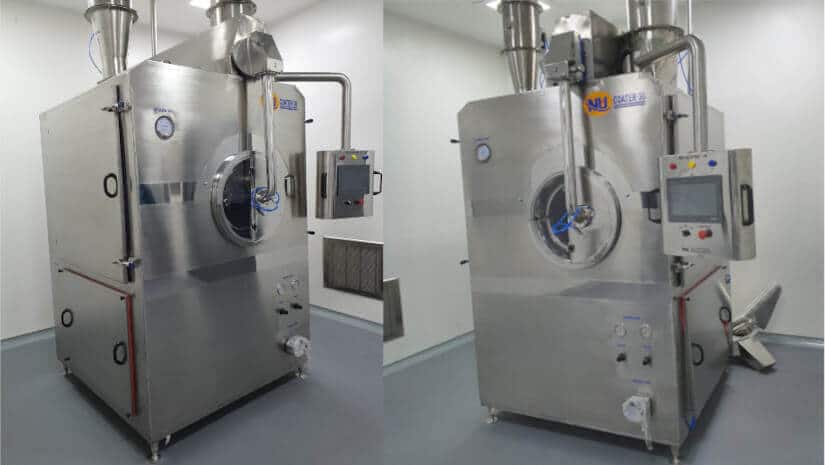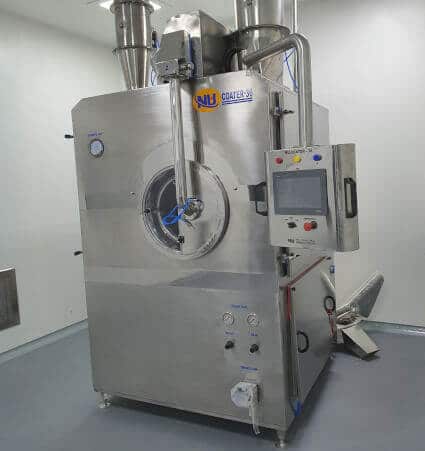
Types of coating Equipment
- Standard Coating Pan
- Perforated Coating Pan
- Fluidized Bed Coater / Air Suspension System
Standard Coating Pan
Standard coating pan gadget includes a round steel pan set up on a stand particularly in angular position. the pan is 8-60 inches in diameter and is rotated by a horizontal axis by a motor. Hot air is sent to the pan and the surface of the tablet bed. And is exhausted through ducts position through the front of the pan. Coating solutions are delivered to the drug by spraying or spraying the rotating tablet on the bed. By ladling or spraying the coating solution is applied to the tablet bed. Use of an atomizing system to spray the liquid coating material onto the tablets produces a faster more even distribution of the solution or suspension. spraying can significantly reduce the drying time between solution application in sugar-coating processes and allows for continuous application of the solution in film coating.
Perforated Coating system
Perforated Coating system is used in two cases totally perforated or partially perforated drum, which rotates in an enclosed housing on its horizontal axis. The drying of coating material by perforated coating system is better as compared to other conventional methods. This system makes a huge compensation in time.
Fluidized Bed Coater / Air Suspension System
Fluidized Bed Coater is a highly efficient drying system. Fluidization of the tablet mass is achieved in a columnar chamber by the upward flow of the drying air. The air flow is controlled to draw more air in the middle of the column, which causes the tablet to rise in the center. In some units a small column is used to control the movement of the tablet inside the main column. Coating solutions are applied continuously to the bottom of the chamber with a spray nozzle located above the chamber of the bed.
Types of Tablet Coating Process
- Film tablet coating
- Sugarcoating
- Gelatin Coating
- Enteric coating
- Compression coating
- Electrostatic Coating
- Aqueous Film Coating
- Organic Coating
- Dip Coating
- Vacuum Film Coating
Film coating of tablet
Film coating is developed to reduce the time consumption and operator skills as compared to the sugar coating process.
Film coating is a technique in which a thin layer/coat of a polymer is deposited over the tablet or particulate.
This is the most effective and most used technique.
The tablet coated by this technique has the same size., structure and mass just as the unique compress tablet.
An ideal film coating material should have the following properties.
- It should have solubility which is required for use.
- It should be elegant in looking.
- It should be stable in heat, light, and air.
- It should possess a pleasant odor and taste.
- It should be non-toxic.
- It should be easily printable on a high-speed machine.
- It should be compatible with other coating material.
- The ease of application should be there.
- No bridge or fill configuration.
Sugar Coating Tablet
The sugar coating process involves several steps, the duration of which ranges from a few hours to a few days. This is especially true in the case of the pan loading technique. New techniques utilize spraying systems and varying degrees of automation to improve coating efficiency and product uniformity. Regardless of the method used, regardless of the method used a successful sugar coating process yields elegant, highly glossed tablets.
Sugarcoating has the following steps.
- Sealing
It is also called seal coating. It prevents moisture penetration into the tablet core, a seal coat is applied. Without seal coat over wetted tablets would absorb excess moisture, as a result, causes tablet softening or disintegration and affecting the physical or chemical stability of the finished product.
- Sub-coating
The sub-coating is a second layer which is applied to round the edges and enlarge the size of the tablet. Sugarcoating can increase the tablet weight by 50-100%.
- Syrup. (smoothing / color) coating
The syrup coating step of sugar coating is the fulfillment of small holes on the surface of tablets. Caused by the sub-coating site, and to impart the desired color to the tablet. This step requires the most skilled person.
- Finishing
Finishing is a step in which the heat and inlet air is turned off. The outlet air and the container speed is reduced to 12 revolutions per minute. And quickly 3-4 coats are or normal color is applied. The exhaust air is stopped and the last layer of regular syrup is applied without coloring agent. This will increase the show of coat. Now hold the pan, as the tablets are wet and quickly switch to the glass for quarter minutes to half an hour. Let the tablets dry completely in all night.
- Polishing
Polishing is the final stage of sugar coating process in this stage our required luster of tablet is gained. The tablet can be polished in clean standard coating pan’s or canvas-line polishing pans, by carefully applying powdered wax.
Gelatin Coating
It is a method in which one or multiple layers of printed or unprinted gelatin layer is coated on tablets.
The advantages of tablets coated with gelatin are easy to swallow, individually labeled, counterfeiting prevented, of course, masking unpleasant smells or tastes, improving the stability of photosensitive active pharmaceutical ingredients (APIs), and looking like soft gels. Soft gelatin-coated tablets are ideal for double-blind clinical trials, or for active pharmaceutical ingredients that can stimulate the esophagus lining when incorporated into immediate-release tablets (such as bisphosphonates).
Enteric-coated Tablet
The word “enter on” means small intestine. So enteric-coated medication (tablet or capsule) are those medications that their outer covering cover is released in small intestines.
The enteric coat has several advantages.
Some medication is sensitive to stomach acidity and they are degraded in a strongly acidic environment, so therefore these types of medication are coated with such a material that withstand stomach acidity and the active ingredients are released in the small intestine and target drug reaches to general circulation.
The coating material for enteric coat are cheap and easily available.
The mode of tablet engulfing is easy.
Compression coating
The coating which is done with the help of compression is called compression coating.
The procedure of compression coating is as, first, a small size tablet is manufactured by a small punch, then this small tablet is brought under a large punch, the lower cavity of the die is filled with a coating material and the upper side is also covered by coating material and then it is compressed and the tablet with the coating is obtained and this is called compressed coated tablet.
Electrostatic Coating
This is a process in which coating is applied to all those ingredients which conduct charge. A powerful electrostatic charge is imposed to the substrate. And a coating containing ionic particles that are charges to the opponent is sprayed on the charged substrate to achieve completely uniform coverage and integration on the substrate. Complete and uniform coating of the corners and integrations on the substrate is achieved. The adaptability of this method to such relatively non-conductive substrate as pharmaceutical tablets is limited, although one process has been proposed.
Aqueous film coating
Aqueous film coating is the application of a thin layer of an aqueous medium that facilitates the coating process and a thin layer covers all small orifices in the tablet.
Organic Coating
The organic coating is a technique in which organic natural coating material is used for coating a tablet.. the source of origin of organic coating material should be plant or animal, because these are natural sources. these sources are non-synthetic. The organic coating is used for coating those tablets which contain multivitamins or food supplements.
Dip Coating
Dip coating is a coating technique in which coating material is applied to the tablet cores by dipping it to the coating liquids. Traditionally, wet tablets are dried in a coating pan. To achieve the desired coverage alternative sinking and drying steps can be repeated many times. The system lacks speed, perseverance and reliability of sprinkler system. A special tablet coating device was developed, but no drug application was taken.
Vacuum Film Coating
This is a new methodology in which a specially designed buffaloed pot is used. This pot is jacketed with warm water, which is sealed to form vacuum system. The tablets are placed in this vacuum system, which is internally anesthetized with nitrogen before the desired vacuum level. And the coating solution is applied here. The evaporation is caused by predicament and therefore the vapors are removed by a vacuum system, because there is no such thing as rapid heating. The requirements are less and the coating efficiency is high. The organic solvents are used to expeditiously with this coating system with






